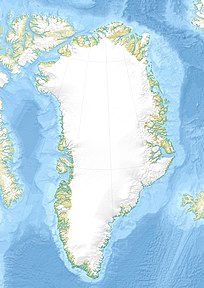Qeqertaq
| Qeqertaq (island) | ||
|---|---|---|
| K'eĸertaĸ | ||
| Qeqertaq (2002) | ||
| Commune | Avannaata Communia | |
| District | Ilulissat | |
| Geographical location | 69 ° 59 ′ 51 ″ N , 51 ° 18 ′ 9 ″ W | |
|
|
||
| Residents | 114 (January 1, 2020) |
|
| founding | around 1830/1845 | |
| Time zone | UTC-3 | |
Qeqertaq [ qɜˈqɜtːɑq ] (according to the old spelling K'eĸertaĸ ) is a Greenlandic settlement in the Ilulissat district in the Avannaata Kommunia .
location
Qeqertaq is located on the southern tip of an island of the same name in the bay-like fjord Qeqertap Ilua , which cuts into the south coast of the Nuussuaq peninsula and flows into the Torsukattak ice fjord . The next town Saqqaq is 24 km to the west .
history
Archaeological finds of stone tools have been made in Qeqertaq, suggesting that the place was inhabited long before the colonial era. In 1793 a house with 21 residents was counted in Qeqertaq. In 1799 an attempt to catch yarn was started on the island. In 1805 it was abandoned and the place was abandoned. After the war, twelve people lived in Qeqertaq again in 1816. The population increased and in 1825 there were already several houses in the village. By 1830 Qeqertaq became a winter udsted . In 1845 the place became a year-round Udsted.
In 1915 Qeqertaq had 68 inhabitants, including a Dane. The Greenlanders lived in eleven houses. The Danish Udsteds administrator lived in a wooden house with two rooms and a kitchen. There was also an official Udsteds administrator's apartment, which was built in 1878 as a half-timbered building with a peat wall facade and roof shingles and had two rooms, a kitchen and a hall. The shop from 1882 was a timber-clad half-timbered house. The bacon house from 1893 was a half-timbered house with a peat wall facade. The salt factory was built in 1911 and consisted of materials from an old storey house from the long-abandoned settlement of Alluttoq (Klokkerhuk). The school chapel was built in 1889 as a half-timbered building with a peat wall facade. In addition to the Udsteds administrator, nine hunters, three fishermen and a trained catechist worked in Qeqertaq.
From 1911 Qeqertaq was a separate municipality within the colonial district of Ritenbenk. It belonged to the 6th regional council constituency of North Greenland. The living quarters Ikorfat , Nuugaaq , Akunnaaq and Naajaat also belonged to her. Qeqertaq was part of the parish of Ilulissat and belonged to the Appat High Catechetical District.
In 1928 Qeqertaq received a new school band. In 1932 a new Udsteds administrator's apartment was built. A Stremelhaus was built in 1942 and a packing house in 1945. Between 1930 and 1950 Qeqertaq had between 72 and 103 inhabitants. Then the population decreased slightly. The twelve fishermen in the village were extremely unsuccessful in 1952 and caught an average of no more than 147 kg of fish, so that 47.57 m² were available in the fish house for each ton of fish, while at the same time it was 0.41 m² in Aappilattoq . In 1963 another packing house was built, which originally stood in Ataa and now also served as a shop.
When Ritenbenk lost its colonial status in 1942, the municipality of Qeqertaq became part of the colonial district of Jakobshavn. In 1950 the place was incorporated into the newly created municipality of Vaigat , but in 1963 it was transferred to the municipality of Ilulissat . During the administrative reform in 2009, Qeqertaq became part of Qaasuitsup Kommunia and in 2018 part of Avannaata Kommunia .
economy
Qeqertaq lives mostly from the halibut fishery . In the past, the local fishermen's prey was more diverse; different types of fish and sharks were fished. The fish factory in Qeqertaq has been operated by Royal Greenland since 2013 . Qeqertaq is also visited by tourists from Ilulissat . Further job opportunities can be found in the service sector and in administration.
Infrastructure and supply
In the north is the Qeqertaq heliport , which connects the settlement to the surrounding area by air. Qeqertaq is also served weekly by the Disko Line . A network of trails runs from north to south of Qeqertaq.
Nukissiorfiit is responsible for the technical supply. The water is supplied by seawater desalination , while a diesel power plant produces electricity. Oil stoves ensure the heat supply. Garbage and sewage are disposed of in the far north on the landfill. TELE Greenland is responsible for telecommunications.
Development
The Iisaap Atuarfia teaches about 15 students from first to ninth grade. In Qeqertaq there is also an infirmary, a Pilersuisoq branch and a community workshop. In 1992 a new church was built. Two buildings in Qeqertaq are classified as worthy of conservation.
Population development
The population of Qeqertaq doubled between the 1970s and the 2000s. Since then, however, it has fallen again by a third. After Saqqaq, Qeqertaq is the second largest village in the district.

Web links
Individual evidence
- ↑ Map with all official place names confirmed by Oqaasileriffik , provided by Asiaq
- ^ A b Hother Ostermann : Beskrivelse af Distrikterne i Nordgrønland: Ritenbenk District. De enkelte Bopladser i Ritenbenk district. Bopladsen Keĸertaĸ . In: Georg Carl Amdrup , Louis Bobé , Adolf Severin Jensen , Hans Peder Steensby (eds.): Grønland i tohundredeaaret for Hans Egedes landing (= Meddelelser om Grønland . Volume 60-61 ). tape 1 . C. A. Reitzel Boghandel, Copenhagen 1921, p. 258 ff . ( Digitized in the Internet Archive ).
- ↑ a b Jens Christian Madsen: Udsteder and bopladser i Grønland 1901–2000 . Atuagkat, 2009, ISBN 978-87-90133-76-4 , pp. 143 f .
- ↑ a b c Qeqertaq at qaasuitsup-kp.cowi.webhouse.dk
- ↑ Population of Qeqertaq 1977–2020 at bank.stat.gl


